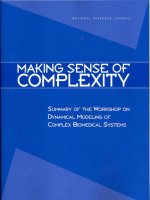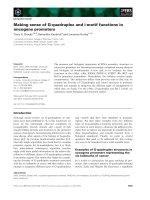Making sense of japanese grammar
Bạn đang xem bản rút gọn của tài liệu. Xem và tải ngay bản đầy đủ của tài liệu tại đây (2.57 MB, 216 trang )
ZELJKO CIPRIS AND SHOKO HAMANO
Japanese
Grammar
A Clear Guide Through Common Problems
MAKING
SENSE OF
Making Sense of
Japanese GrammarMaking Sense
of
Japanese Grammar
A Clear Guide
Through Common Problems
Zeljko Cipris
and
Shoko Hamano
UNIVERSITY OF HAWAI‘I PRESS
HONOLULU
© 2002 University of Hawai‘i Press
All rights reserved
Printed in the United States of America
07 06 05 04 03 02 6 5 4 3 2 1
Library of Congress Cataloging-in-Publication Data
Cipris, Zeljko
Making sense of Japanese grammar : a clear guide through common problems / Zeljko
Cipris and Shoko Hamano.
p. cm.
Includes index.
ISBN 0–8248–2497–0 (cloth : alk. paper)—ISBN 0–8248–2583–7 (pbk. : alk. paper)
1. Japanese language—Grammar. 2. Japanese language—Textbooks for foreign
speakers—English. I. Hamano, Shoko. II. Title
PL535 .C65 2002
495.6'82421—dc21
2002018776
Camera-ready copy for this book was prepared by the authors.
University of Hawai‘i Press books are printed on acid-free paper
and meet the guidelines for permanence and durability of
the Council on Library Resources.
Printed by The Maple-Vail Book Manufacturing Group
Contents
Acknowledgments ix
Introduction xi
Part 1. Grammatical Categories and the Basic Architecture of a
Sentence 1
1 The subject corresponds to an item around which an event evolves 3
2 Use the verb at the end! 5
3 An explicit subject is optional 6
4 Pay attention to the last part of a sentence 7
5 There are three types of verb-like constituents 9
6 The noun in the sentence gakusei-desu is not the subject! 11
7 Japanese speakers avoid certain pronouns 13
8 You cannot always guess the grammatical category of a Japanese
form from the grammatical category of its English counterpart 15
9 Dictionary forms of all Japanese adjectives end with -ii, -ai, -oi,
or -ui 16
10 “Noun” is an open category in Japanese 17
11 Use the same word order for questions. Attach -ka to a statement
to turn it into a question 19
12 Do not hesitate to use the same verb over and over again 22
13 Japanese particles are postpositions 23
14 Classification of particles 25
Part 2. Phrase Particles: Marking the Functions of Noun Phrases in
a Sentence 29
15 A phrase particle determines the function of the noun 31
16 The particle -wa identifies what the sentence is about and urges
the listener to pay attention to the part that follows 33
17 The particle -mo adds the preceding noun phrase to a list of objects 36
18 Use of -wa and -mo presupposes a contextual set 38
19 -ga is the subject marker; -o is the direct object marker 40
20 -ga and -o mark a fresh participant; -wa marks a familiar
participant already anchored in a context 43
21 Do not attach -wa to interrogative WH-phrases 46
v
22 Only one direct object particle -o appears per verb 48
23 The subject and the direct object are the primary grammatical
categories 50
24 Two types of locational particles: -de and -ni 53
25 Three reasons not to use phrase particles 57
26 “Exceptional” uses of -ga 60
27 Grammatical reasons for alternations of particles 64
28 The person marked with the particle -ni is an active participant
in an interaction 66
29 The person marked with the particle -to is a “reciprocal”
participant in an interaction 71
30 Certain auxiliary verbs take the non-subject participant particle -ni 73
31 The auxiliary verb -morau comes with -ni; the auxiliary verbs
-ageru and -kureru do not 76
32 Another consequence of the double-o constraint 79
33 Phrase particles are powerful! 80
Part 3. Expanding Noun Phrases 83
34 The particle -no between two nouns turns the first noun into a
modifier 85
35 A noun modified by an adjective functions like a noun 87
36 The modifier consistently precedes the modified 88
37 Spatial relationships are expressed with stacked nouns 90
38 The particle -no mediates a wide range of relationships.
Mekishiko-jin-no tomodachi, for instance, means either “a friend
of a Mexican” or “a friend who is Mexican” 92
39 The particle -to connects noun phrases representing separate
objects 94
40 Na-nouns behave like nouns, but they have “fuzzy” meanings 96
41 To say something more complex, use complex noun phrases 99
42 The head noun of a complex noun phrase carries with it only the
particle which marks its function in a larger sphere 101
43 Japanese does not employ WH-phrases for creating complex
noun phrases 103
44 Mekishiko-jin-no tomodachi “a Mexican friend” is a complex
noun phrase 105
45 Atarashii tomodachi “a new friend” is also a kind of complex
noun phrase 107
46 One more way to create a complex noun phrase
109
47 No is for a familiar event; koto is for an abstract idea 111
Part 4. Tense and Events 115
48 There are only two tenses in Japanese: non-past and past 117
vi
49 Special use of past tense forms 119
50 Te-forms connect very closely related events 121
51 Tense markers separate events 124
52 Events are tied with varying degrees of cohesion inside a sentence 129
53 Two perspectives for tense inside a subordinate clause 133
54 The main clause perspective means involvement 137
55 The speaker’s perspective means incidental connection, speaker’s
recollection, or speaker’s reasoning 140
Part 5. Miscellaneous Topics 143
56 Hai and ee mean “I agree” or “I hear you”; iie means “I disagree” 145
57 Are “that” is for things known to both speaker and hearer;
sore “that” is for something just mentioned 149
58 The longer and vaguer, the more polite 152
59 Polite forms and direct forms 153
60 Reality consists of continuous-grade scales; language makes
things discrete 156
61 Interpretations of -te-kuru/-te-iku 159
62 Expressing solidarity with -te-kuru/-te-iku 163
63 -n-da expresses expectation of mutual understanding 165
64 -n-da-kara does not provide personal information. Do not
overuse it! 167
65 There are ways to identify hidden subjects 170
66 Do not be intimidated by apparent complexity 175
Answers to the Questions 179
Glossary 193
Index 197
vii
Acknowledgments
We owe our thanks to a number of people who helped us with this book. Among
others, directly instrumental in bringing the book about were Susumu Kuno,
Patricia Crosby, Ann Ludeman, Nancy Woodington and two anonymous reviewers
for the University of Hawai‘i Press. We are sincerely grateful to them for their
encouragement and constructive suggestions. We are also grateful for the insights
of Stanley Dubinsky and Wesley Jacobsen. All errors are strictly ours, of course.
ix
Introduction
The purpose of this book is to explain basic principles underlying a wide range
of phenomena in Japanese. We hope that our readers will realize that many
phenomena which at first look idiosyncratic and Japanese-specific are closely
connected to general principles which are not so exotic.
The audience we target is people who have little or no linguistic training and
who may be unfamiliar with grammatical concepts. If you have never heard of
the difference between transitive and intransitive verbs, but are genuinely interested
in learning the Japanese language, this book is for you. We hope that even if you
hated your English grammar in high school, you will still find the explanations
in this book comprehensible.
With this objective in mind, we have limited the use of grammatical terms to the
minimum. This means that, whenever possible, we have opted for simple, non-
technical terms that an average English speaker knows. We have not used terms
like “verbal aspect” or “modality,” which linguists prefer. Instead, we have
talked of “speaker’s perspective,” “simple vs. complex event,” etc.
Although we assume very little knowledge of Japanese grammar, we do assume
some familiarity on your part with the Japanese language. You need not be an
advanced student. You can have started learning Japanese only a few weeks ago.
You can begin reading this book while continuing your language study. But the
book does not teach you specific expressions or patterns in Japanese. For example,
it does not teach you how to say “Good morning” or how to create past tense
forms. You need to learn those with an introductory textbook. Neither will the
book teach you how to study Japanese. We focus on things that might puzzle
you and things that might cause you a variety of problems in the future. For
example, we explicitly explain that the noun before the form -desu is not the
subject of a sentence. This is to prevent various difficulties which might arise
later and persist if not properly handled at an early stage.
Intermediate and advanced students who have been accumulating questions about
the structure of Japanese will also benefit from Making Sense of Japanese
Grammar, because it gives coherence to many features of Japanese that are
treated separately in existing textbooks or resource books.
xi
The knowledge that we rely on in this book is the accumulated knowledge of
linguists specializing in Japanese and comparative grammar. We differ from
them in addressing non-specialists. We do not tax you with superfluous
information. Even though some linguistic facts are of extreme interest to
professional linguists, if we think that you intuitively understand and utilize
them in learning or processing Japanese, we do not burden you or ourselves with
the tedious task of explaining them. We provide only those pieces of information
which are essential to understanding Japanese. In other words, we are trying to
help you make sense of Japanese grammar in order to master the language.
We believe that, when apparent differences between Japanese and English are
resolved using universal principles, true intercultural communication takes place.
All of us will become more tolerant of surface differences, with the understanding
that we are all humans with same cognitive processes. Our ostensible differences
are only skin deep, or language deep. We believe that this message transcends
the realm of language acquisition.
Now, how to use this book. Since any grammar book, alas, is far from a thriller,
we do not recommend that you read ours from cover to cover on a rainy afternoon.
(If you tried, your eyes would swiftly glaze over, especially if you like to read in
a reclining position!). It is far more effective to absorb its contents a little at a
time.
You will notice that the book is divided into five parts consisting of short units,
with a great deal of cross-referencing. Each unit begins with a maxim-like
heading such as “Do not hesitate to use the same verb over and over again” or
“Te-forms connect closely related events.” The glossary provides short definitions
of terms which might require clarification. Indexed items lead you to the pages
where they are discussed and explained.
You might choose to think of this manual as a bowl of highly potent, knowledge-
enhancing nuggets which should be thoughtfully chewed, one at a time. The
order in which you ingest them is not crucial. Feel free to range back and forth,
or to dip into the book at random. Glance over the table of contents, or leaf
through the pages, to find items that strike you as intriguing, and start reading.
Or go to the index to find the pages where something you are interested in is
explained. When you wish to test your understanding, do the mini-exercises
found at the end of each unit. The keys to the exercises are at the end of the
book.
If you find a unit beyond your level, simply go to one of the earlier units on
related topics, which are suggested at the end of each unit. If a unit is unclear at
first reading, do not give up but read through it once more, slowly and attentively.
When the Zen master Ikkyu was asked to write a maxim of the highest wisdom,
xii
he wrote a single word: “Attention.” We cannot improve on old Ikkyu’s advice,
and are confident that a relaxed and focused approach will enable you to attain
grammatical enlightenment. Once internalized, the information contained in these
pages will illuminate Japanese grammar with surprising clarity.
Enjoy your study, and please keep in mind that anyone can master Japanese
grammar and the Japanese language itself. All it takes is good humor and
perseverance.
Good luck!
A note to teachers
Making Sense of Japanese Grammar will also be of interest to Japanese-language
teachers whose specialty is not necessarily linguistics. We hope the book will
clarify some points which they have been teaching over the years but which still
trouble them because they are difficult to explain to students. Even instructors
with a linguistics background may find some parts helpful in their teaching
because of the accessible way the concepts are explained.
We encourage teachers of Japanese to utilize Making Sense of Japanese Grammar
as supplementary reading for students at all levels. The teacher may choose to
assign a few units as early as the first weeks of a beginning class. Additional
units can be assigned whenever they help to clarify what is being studied. We
hope that this approach will prove beneficial throughout the student’s formal
learning career, and well beyond it. Even a perfectly fluent speaker of Japanese
may find the book a useful reference from time to time.
We strongly encourage both teachers and students to write to us with their
comments and suggestions, in order to help us make the book’s future editions
ever more readable and helpful.
A note on romanization and notation
The romanization in transliterations follows the Hepburn style, except for long
vowels, which are marked by doubling the vowel rather than by a long mark.
xiii
Asterisks mark ungrammatical sentences.
Part 1
Grammatical Categories and the Basic
Architecture of a Sentence
1
The subject corresponds to an item around which an event
evolves
We perceive the physical world as sequences of processes or conditions, which
we broadly call “events” in this book. We typically think of an event as one
evolving around a single entity—possibly a person, an object, or a group of
people or objects. This type of perception has a linguistic counterpart. We express
an event as a sentence, and its key component as the subject of a sentence, as in
the following English sentences, where the items in boldface are the subjects:
After a moment of hesitation, Genji offered his hand to Murasaki.
The leaves swayed in the gentle breeze.
For centuries, Kyoto was the capital of Japan.
In the case of sentences describing a process, like the first two sentences above,
the subject typically corresponds to the agent which acts or moves. In the case of
a sentence describing a condition, as in the last sentence, the subject is the item
the sentence is about.
As is clear from the examples above, subjects in simple English declarative
sentences usually appear immediately before verbs. In Japanese, this criterion of
position is not relevant for identifying a subject, but for the moment, it is sufficient
to get us started. You will at least have an idea of what prototypical subjects
look like in English sentences, and you will also be able to identify the subject in
Japanese sentences like the following:
Ehon-ga tana-kara ochimashita.
picture book-Subject shelf-from fell
“A picture book fell from the shelf.”
No doubt, you correctly chose
ehon “picture book” as the subject.
Almost as important as the subject is the concept of the direct object. A prototypical
direct object is an item whose condition the subject changes by his/her action,
like the items in boldface below:
I tore the letter in half.
Ryoko woke her brother before dawn.
The target of the subject’s action in the following examples is slightly less
3
prototypical, but is still treated as a direct object:
I checked the train schedule.
Ryoko saw her brother among the crowd.
The direct object, then, is the second most important party in an event after the
subject. This is reflected in English by the fact that direct objects typically
appear immediately after the verb in declarative sentences, as central to events.
Again, position is not a reliable criterion for identifying a direct object in Japanese,
but it will suffice for the moment.
For related topics, see also Units 3, 6, and 23.
4
2
Use the verb at the end!
The basic word order in English is Subject-Verb-direct Object (SVO). The basic
word order in Japanese, on the other hand, is Subject-direct Object-Verb (SOV),
as shown by the following examples:
SOV
Kyoo-wa Sachiko-ga kono hanashi-o yomimasu.
today Sachiko-Subject this story-Object (will) read
“Today, Sachiko will read this story.”
SV
Kyoo-wa Sachiko-ga ikimasu.
today Sachiko-Subject (will) go
“Today, Sachiko will go.”
The SO sequence, however, is not always observed in practice. You can switch
the subject and the direct object around. What you must do is to place a verb (or
something like a verb—see Unit 5) at the end of a sentence. Linguists call this
property of Japanese right-headedness, because if you write a sentence from left
to right, you put the verb—the most important part of the sentence—at the end
of a sentence.
You need not worry about the order of the other elements as long as you put the
verb at the end. You can use either SOV or OSV, although the emphasis is
slightly different depending on which one comes first. The following sentence is
also grammatical:
OS V
Kyoo-wa kono hanashi-o Sachiko-ga yomimasu.
today this story-Object Sachiko-Subject (will) read
“Today, Sachiko will read this story.”
For related topics, see also Units 3, 4, 5, 6, and 36.
5
3
An explicit subject is optional
English requires an explicit subject in every sentence except imperative sentences
(e.g., “Stop!”). In Japanese, however, the subject is optional for any type of
sentence. So you hear minimal sentences like the following:
Tabemasu.
eat
“I will eat.”
Oishii-desu.
delicious-Copula
“It is delicious.”
If you know Spanish, you might say that Spanish operates the same way, but
there is a difference. In Spanish, the verb agrees with the person and the number
of the subject (for example, [yo] voy “I go,” but [ella] va “she goes”). Person
and number are crucial concepts determining the subject in English as well. For
this reason, if a Spanish sentence has no explicit subject, it is relatively easy for
an English speaker to guess who or what its subject is.
By contrast, a Japanese verb is insensitive to such distinctions; the identical verb
form is used for all persons and numbers. For instance, the sentence
tabemasu may mean “I will eat,” “we will eat,” “you will eat,” “he will eat,”
“she will eat,” “they will eat,” or “it will eat.”
This is not to say that a Japanese verb provides no information about the identity
of the subject. The types of information, however, are quite different from those
you are familiar with, as we explain in Unit 65. For the moment, try to recover
an appropriate subject from the context.
Checking your comprehension: Try to identify from the context the subject for
each of the following sentences:
(1)
(2)
(1) Kinoo anime-o mimashita. (2) Totemo omoshirokatta-desu.
6
For related topics, see also Units 2, 4, 6, 7, and 65.
4
Pay attention to the last part of a sentence
English speakers tend to pay attention to the initial part of a sentence. This is
because the subject and the verb appear at the beginning in English, providing
core information early.
Also, although English speakers have the option of dropping a significant portion
of a sentence in responding to a question, the initial part of the sentence remains.
Would you have been able to see Bread and Roses if you had known it was
showing in town?
Yes, I would have been able to see it if I had known it was showing in town.
Yes, I would have been able to see it if I had known it was showing.
Yes, I would have been able to see it if I had known.
Yes, I would have been able to see it.
Yes, I would have been able to.
Yes, I would have been.
Yes, I would have.
Yes, I would.
In Japanese, the verb appears at the end. Since tense information appears with
the verb at the very end, until you hear the last part, you do not necessarily know
if an event has already happened or is yet to happen. Nor can you tell whether an
event is happening at all until you hear the last part, because a negative marker
appears at the end of a sentence. This results in a corresponding difference in
strategy in answering a question. For Japanese speakers, everything but the last
part of a sentence can be dropped.
Kimi-mo kinoo-no rokuji-ni Hachikoo-mae-ni ita-n-desu-ka.
“Were you in front of [the statue of] Hachiko at 6 yesterday, too?”
Ee, (boku-mo) Hachikoo-mae-ni ita-n-desu.
“Yes, I was in front of [the statue of] Hachiko, too.”
Ee, (boku-mo) ita-n-desu.
“Yes, I was, too.”
7
Always pay attention to the last part of a sentence. Make a habit of repeating the
same final pattern that your teacher uses. Since a question and a statement in
Japanese differ only with respect to the presence or absence of the last particle
-ka (see Unit 11), by repeating essentially the last part, you will produce
grammatical and highly natural exchanges.
Checking your comprehension: Now you can answer the following question
grammatically even without necessarily knowing its meaning:
Shuumatsu-ni Washinton-de hansen-demo-ga aru-to iu hanashi-o kiita-n-
desu-kedo, sanka-shimasu-ka.
For related topics, see also Units 2, 3, 5, 11, and 36.
8
5
There are three types of verb-like constituents
When we say that a verb appears at the end of a Japanese sentence, we actually
mean by the word “verb” one of the following three types of verb-like minimal
sentences:
1. Verb
2. Adjective + copula (
-desu and its variations)
3. Noun + copula
There are four conjugational forms for each type. The first type, verb, is exemplified
by:
nomimasu nomimasen/nomanai-desu
“drink” “do/does not drink”
nomimashita nomimasen-deshita/nomanakatta-desu
“drank” “did not drink”
The second type, adjective + copula, is exemplified by:
tanoshii-desu tanoshi{ku-arimasen/ku-nai-desu}
“am/is/are enjoyable” “am/is/are not enjoyable”
tanoshikatta-desu tanoshi{ku-arimasen-deshita/ku-nakatta-desu}
“was/were enjoyable” “was/were not enjoyable”
The last type, noun + copula, is exemplified by:
gakusei-desu gakusei-{ja-arimasen/ja-nai-desu}
“am/is/are (a) student(s)” “am/is/are not (a) student(s)”
gakusei-deshita gakusei-{ja-arimasen-deshita/ja-nakatta-desu}
“was/were (a) student(s)” “was/were not (a) student(s)”
9
Can you tell which types the following sentences represent?
Sugokatta-desu.
“It was awesome.”
Chigaimashita.
“It was different.”
The parts in boldface would have indicated that they are type 2 (adjective +
copula) and type 1 (verb), respectively.
This unit uses polite verb forms. For direct forms, see Unit 59. Forms such as
nomanai-desu “do/does not drink” and
nomanakatta-desu “did not drink” derive from direct forms and are gaining
acceptance as alternative polite forms.
Checking your comprehension: Which type does each of the following sentences
represent? Pay attention to boldface.
Tabesasemasen-deshita.
“I didn’t let him eat.”
Okitaku-nakatta-desu.
“I didn’t want to get up.”
Ikitaku-naku narimashita.
“I lost interest in going.”
Amari wakari-yasui aidea-ja-nai-desu.
“It is not an idea that is very easy to understand.”
For related topics, see also Units 6 and 59.
10









